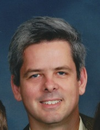Biography:Michael Christopher Wendl
Michael Wendl | |
|---|---|
 | |
| Nationality | United States |
| Known for | Phred base calling Couette flow[1] DNA sequencing theory |
| Scientific career | |
| Fields | Computational biology Probability |
| Doctoral advisor | Ramesh K. Agarwal[2] |
| Website | wendl |
Michael Christopher Wendl is a mathematician and biomedical engineer who has worked on DNA sequencing theory,[3] covering and matching problems in probability, theoretical fluid mechanics, and co-wrote Phred.[4] He was a scientist on the Human Genome Project and has done bioinformatics and biostatistics work in cancer. Wendl is of ethnic German heritage and is the son of the aerospace engineer Michael J. Wendl.[5]
Research Work
Theoretical Fluid Mechanics
The problem of low Reynolds number flow in the gap between 2 infinite cylinders, so-called Couette flow, was solved in 1845 by Stokes.[6] Wendl reported the generalization of this solution for finite-length cylinders,[1][7] which can actually be built for experimental work, in 1999, as a series of modified Bessel functions [math]\displaystyle{ I_1 }[/math] and [math]\displaystyle{ K_1 }[/math]. He also examined a variety of other low Reynolds number rotational devices and shear-driven devices, including a general form of the unsteady disk flow problem, for which the velocity profile is:[8]
[math]\displaystyle{ u(r,z,t) = \Re\left(e^{i\sigma t}\left[\frac{r\cdot\sinh(1+i)\beta z}{\sinh(1+i)\beta \phi}\right] + \frac{2}{\phi}\sum_{j=1}^{\infty}\frac{(-1)^j\cdot\alpha_j^2\cdot\sin(\alpha_j z)\cdot I_1\left(\sqrt{i R \sigma + \alpha_j^2} r\right)}{(i R \sigma + \alpha_j^2)\cdot I_1\left(\sqrt{i R \sigma + \alpha_j^2}\right)}\right) }[/math]
where [math]\displaystyle{ \sigma }[/math], [math]\displaystyle{ R }[/math], [math]\displaystyle{ \beta }[/math], and [math]\displaystyle{ \phi }[/math] are physical parameters, [math]\displaystyle{ \alpha_j }[/math] are eigen-values, and [math]\displaystyle{ (r, z, t) }[/math] are coordinates. This result united prior-published special cases for steady flow, infinite disks, etc.[8]
Covering and Matching Problems in Probability
Wendl examined a number of matching and covering problems in combinatorial probability, especially as these problems apply to molecular biology. He determined the distribution of match counts of pairs of integer multisets in terms of Bell polynomials,[9] a problem directly relevant to physical mapping of DNA. Prior to this, investigators had used a number of ad-hoc quantifiers, like the Sulston score, which idealized match trials as being independent. His result for the multiple-group birthday proposition[10] solves various related "collision problems", e.g. some types of P2P searching.[11] He has also examined a variety of 1-dimensional covering problems (see review by Cyril Domb[12]), generalizing the basic configuration to forms relevant to molecular biology.[13][14] His covering investigation of rare DNA variants with Richard K. Wilson[15] played a role in designing the 1000 Genomes Project.[16]
Bioinformatics and Biostatistics
Wendl co-wrote Phred, a widely used DNA trace analyzer that converted raw output stream of early DNA sequence machines to sequence strings.[17][18] He has also contributed extensively to biostatistical analysis of cancer studies.[19][20]
External links
- Michael Christopher Wendl at the Mathematics Genealogy Project
- Michael Christopher Wendl publications indexed by Google Scholar
References
- ↑ 1.0 1.1 Bordag LA et al. (2005) Interaction of a rotational motion and an axial flow in small geometries for a Taylor–Couette problem , J. Fluids and Structures 20(5), 621–641. The authors comment directly on Wendl's solution appearing so long after the classical problem discussed by Stokes in 1845: "It is also a bit astonishing that the exact analytical solution for the azimuthal component of the Taylor–Couette flow profile with boundary conditions on cylinder caps was obtained just recently in the work of Wendl (1999). His results expose the strong influence of caps on flow profiles."
- ↑ https://www.genealogy.math.ndsu.nodak.edu/id.php?id=37582
- ↑ Dorman, N (2006) The long and short of it, BioTechniques 41(4), pp 367.
- ↑ Ewing, B., Hillier, L., Wendl, M.C., and Green, P. (1998) Base-calling of automated sequencer traces using phred. I. Accuracy assessment. Genome Research 8(3), 175–185. PMID 9521921 full article
- ↑ P Hummel and N Fuhry: "Sackelhausen im Banat" Volume 3, published by Heimatsortsgemeinschaft Sackelhausen, Reutlingen FRG, 2007, pages 2236-2237.
- ↑ G.G. Stokes(1845) ``On the theories of the internal friction of fluids in motion and of the equilibrium and motion of elastic solids, in Mathematical and Physical Papers, pp. 102-104, Cambridge, UK: Cambridge University Press, 1880.
- ↑ Wendl MC (1999) General Solution for the Couette Flow Profile, Physical Review E 60(5), 6192–6194.
- ↑ 8.0 8.1 Wendl MC (2001) Mathematical analysis of coaxial disk cellular shear loading devices, Review of Scientific Instruments 72(11), 4212-4217.
- ↑ Wendl MC (2005) Probabilistic assessment of clone overlaps in DNA fingerprint mapping via a priori models, J. Comp. Biol. 12(3), 283-297.
- ↑ Wendl MC (2003) Collision probability between sets of random variables, Stat. Prob. Lett. 64(3), 249–254.
- ↑ Hautakorpi, J and Schultz, G (2010) A Feasibility Study of an Arbitrary Search in Structured Peer-to-Peer Networks, IEEE Computer Communications and Networks, Proc ICCCN, pp 1–8.
- ↑ Cyril Domb (1989) Covering by random intervals and one-dimensional continuum percolation, J. Stat. Phys. 55, 441-460.
- ↑ Wendl MC (2008) Random covering of multiple one-dimensional finite domains with an application to DNA sequencing, SIAM J. Appl. Math. 68(3), 890-905.
- ↑ Wendl MC, Kota K, Weinstock GM, and Mitreva M (2013) Coverage theories for metagenomic DNA sequencing based on a generalization of Stevens' theorem, J. Math. Biol. 67(5), 1141-1161.
- ↑ Wendl MC and Wilson RK (2009) The theory of discovering rare variants via DNA sequencing, BMC Genomics 10 art. 485.
- ↑ Altshuler DM et al. (2010) A map of human genome variation from population-scale sequencing, Nature 467(7319), 1061-1073.
- ↑ Koboldt, D. C. and Miller, R. D. (2011) Identification of Polymorphic Markers for Genetic Mapping, chapter 2 in "Genomics: Essential Methods", John Wiley and Sons.
- ↑ Highsmith, W. E. (2006) Electrophoretic Methods for Mutation Detection and DNA Sequencing, chapter 9 in "Molecular Diagnostics for the Clinical Laboratorian", Humana Press
- ↑ Wendl MC et al. (2011) PathScan: A tool for discerning mutational significance in groups of putative cancer genes, Bioinformatics 27(12), 1595-1602.
- ↑ Lu C, Xie M, Wendl MC et al. (2015) Patterns and functional implications of rare germline variants across 12 cancer types, Nature Comm. 6 art. 10086.

